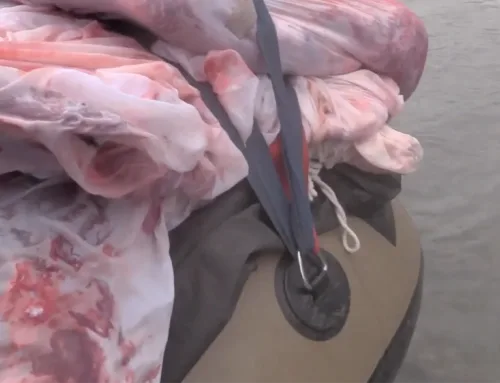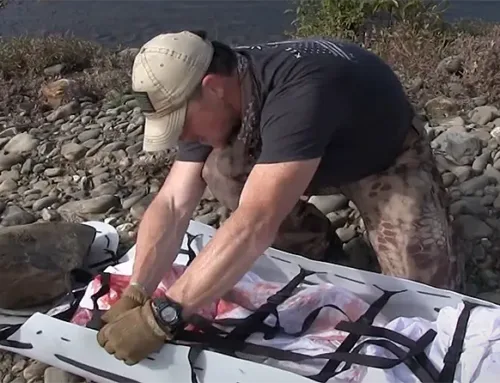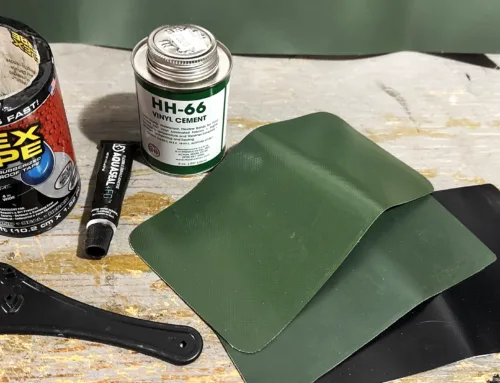As we headed east, out of Fairbanks, my comrade and I were jubilant. We had spent the last year planning this trip—one of a lifetime. As the traffic thinned and the dust overtook the metallic luster of my Toyota, I could think of nothing but the sweet smell of autumn leaves and the grandeur of hunting during the most captivating time of year.
As we drove closer to our put-in locale along the shallow, rock-strewn headwaters of Birch Creek, I conjured up expectations of our hunt that would be difficult to meet. However, antlers are to Alaskans what the crucifix is to Christianity; and we were hoping to fulfill our duty as true Alaska hunters. We knew we were in for a tough-going ten days, as all Alaskan adventures are loaded to the hilt with adversity. What we didn’t know was how stringent Mother Nature would prove to be. It wasn’t long, however, before our wilderness survival and river experience were to be validated.
The rolling hills of white spruce interwoven with paper birch and aspen painted a mesmerizing picture and filled our eyes with vibrant images. As we floated around meandering bends and over shallow riffles, we strained to see the riverbank ahead in case our quarry stood in plain sight. The first day was spent pulling and dragging our inflatable over and around river obstructions, such as logjams, beaver dams, and widely overhanging sweepers. After nearly eight hours of river floating we had only traveled 6 miles…only 119 miles to go. Needless to say, that night we slept as if we hadn’t slept in weeks. Our plan of attack was to rise early and begin our river decent at daybreak. If Lady luck were with us we would encounter an early-rising moose and harvest him. As chance dictated, it worked. We floated within 75 yards of a young bull, standing midstream, and my partner squeezed off a couple of rounds with his .338. The bull dropped ten feet from the water’s edge, and half of our objective was achieved. We soon realized that harvesting our quarry was every bit the easy part; it’s the struggle ahead that stretched our endurance and sharpened our will to persevere.
Although we were carrying out our river adventure in a sub-standard inflatable, an 11-foot American Camper with 800-denier hypalon fabric, we felt as though we could harvest two moose and float safely back to civilization. We awoke the second morning with hopes of duplicating the previous day’s luck. After floating about 6 hours we rounded a meandering bend, which had an inconspicuous slough connecting the river to an oxbow pond. As we floated past the tiny slough, no larger than ten-foot wide, I caught a glimpse of young mulligan exiting the water and heading into the thick willow shrubs. I contemplated for a split second on whether I was going to take the young moose, but dismissed those thoughts as my aim grew steady and my finger squeezed off a round. Before I new it we were field dressing another moose. We soon realized how foolish we were to believe that we could safely float out all our meat, equipment and personnel in such a small inflatable.
The raft was rated for up to 1,500 pounds, but I have learned that one can fill almost any craft completely and run out of room before reaching the weight limit. Luckily we harvested two small moose, approximately 650 pounds total weight. What we failed to comprehend was that we had over 100 miles to travel with about 1,100 pounds resting heavily on our dinghy-sized raft. However, everything was going great until the topography changed slightly and the riverbed metamorphosed from round-shaped gravel into jagged metamorphic rock, which quickly compromised the integrity of our cheaply-made raft. I recall the panic in my friend’s eyes when our raft struck a sharp sleeper, a submerged rock hidden below the surface of the water. The left rear chamber of our craft exploded like we had been hit by artillery at close range. The thunderclap blast of the explosion left us dumbfounded and sinking rapidly, our meat soaked by the rapid upsurge of cold water. Once we paddled frantically to shore and hurriedly unloaded the craft, we pulled it out of the water and inspected the damage. The results were uninspiring, as the force of the exploding air chamber caused an eighteen-inch laceration to the bottom of the raft. It seemed as though we were literally “up the creek without a paddle.” In this case, the paddle was hope.
Still nearly 100 miles to go and no hope in sight, we bonded our experience and vowed not to give up—regardless of what the next eight days had in store for us. I blew the dust off my raft repair kit and unfolded the hypalon patch material. I then sewed the jagged laceration with an industrial needle and thick nylon thread. After 24 hours we were once again afloat and heading downstream. The scenery was intense; the trees cast brilliant hues of yellow orange and assorted greens. The river was moody, as a constant rain imputed to its high state. I grew concerned as more tributaries bled into and fueled the fury of this normally meandering river. Certain sections grew torrid, the current confused and unpredictable. Our small raft was tossing about and floating at the mercy of the main channel. Although I was an experienced river runner, the heavy load caused the raft to become sluggish to my oar commands, which rose my “pucker factor” ten fold with each rapid. Trying to set the raft’s course and tackle each standing wave bow first was challenging and the uncertainty of the repaired air chamber constantly reminded me that chance had much to do with our deliverance.
Another devastating setback came when our right rear air chamber ruptured after striking another razor-sharp sleeper. Smart thinking beforehand facilitated a speedy repair, as three layers of Duct tape were applied to each chamber after the initial rupture. We were gaining more river savvy as the takeout grew nearer, all the while being awestruck by the riparian landscape. Each day presented with more discoveries of self-reliance and inner solitude. We were facing danger and adversity head on and loving every minute of each challenge, which reminded me of an old cliché…”be careful what you wish for, you just might get it.”
We had lined a torrent section of Class III water and were approaching the confluence of Wolf Creek, when we attempted to maneuver a semi-challenging hole (a depression formed when the river flows abruptly over a rock, or ledge, resulting in a reversal of river flow immediately downstream of the hole). This hazard caught us off guard and our dinghy became entrapped, sideways, in the reversal and flipped over, spilling its contents into the river’s depth. Much equipment and meat floated downstream and eventually either floated out of reach or sank to the bottom. The latter proved to be the biggest challenge for recovering our paraphernalia, including two game bags, each containing a moose shoulder. Though petrified of the bitter cold current and tannic appearance of the deep pool, we were determined to salvage our harvest. My friend unclothed and jumped headfirst into the frigid September current. Hypothermia was almost certain if he had accidentally struck his head against a rock, or encountered sudden shock from the icy water. However, he exited the river as quickly as he had entered, but game bag in hand. He stood shivering, but alive, and shouting profanity, perhaps trying to convince his body that he was indeed sorry for the agonizing self-punishment. Again, my rapidly acquired savvy told me to convince my friend to extricate the second bag of meat as well; besides, the mere sight of his bodily shrinkage was enough to send me into shock. There wasn’t a chance in hell that I desired to fill his shoes-moose meat or not! After a couple of hours of repositioning equipment and warming up our bodies, we were on our way home. It seemed the difficult portions of the river were behind us, finally. Soon the river slowed its course and meandered about 1 to 2 mph for the remaining 80 miles of our journey. The days were long and nights short, but we could smell the fresh coffee and hot meal waiting on us in the town of Central, AK, just a few miles up from our river takeout.
We paddled non-stop from 6:00 a.m. to 9:00 p.m., eating while floating, stopping only to void occasionally. For six days we drifted and followed the river’s lackadaisical course through marshy lowlands of the Yukon Flats National Wildlife Refuge. The raft had encountered so much damage that there were bubbles pouring out of every repair patch. The inflatable was losing air faster than we could pump it in. While one person rowed, the other person pumped air into the chambers that were deflating. It was an all-day-affair until we reached the takeout.
We had been watching our GPS to pinpoint our takeout locale, and finally it came. Our bodies fatigued…our minds numb from exertion; we exited the raft for the last time. I recounted to my partner an expression from the late Robert Marshall, who wrote, “undoubtedly, the greatest experience of any adventure…is the end.” As I looked upstream and drew upon our most recent ten days, I silently congratulated myself and wondered if I would ever attempt a trip like this again. I recall tossing a smirk to the river, my body beaten by the extended wear and tear. We went in search of a remote wilderness experience, and what we found was much richer-sublimity. A part of that river still grows inside of me, and I recall my Birch Creek adventure every time I drift into the wilds of Alaska. And though I study my endeavors closely and calculate every stroke of the oar, I realize that there is no true demarcation between sublimity and catastrophe. With one false move or stroke of inexperience, the noble quality of a true adventure can become a misadventure. Catastrophe comes when one gives in to the fear within oneself…good judgment becomes clouded; instead, one should channel that fear, making it work for oneself…good judgment is honed and euphoria is achieved.
-Larry Bartlett
Author / Wilderness Guide




